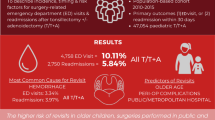Abstract
The aim of our study was to investigate the accuracy of haemorrhage rate in the community (i.e., actual rate versus hospital recorded rate) for tonsil operations. Bleeding episodes were investigated for 695 consecutive patients undergoing tonsillectomy, adenotonsillectomy and tonsillotomy at the Department of ORL, H&NS, MU of Graz, Austria, between January 1 2007 and June 30 2008 by questionnaire. Main purposes of our study were the evaluation of the incidence of postoperative haemorrhage, need for revision surgery, medical care of patients experiencing postoperative bleeding and multiple bleeding episodes. Haemorrhage was defined as any bleeding, be it minimal or significant, after extubation. The study group comprised 407 patients who answered the questionnaire: 61.7% adults, 22.1% school children between 6 and 15 years and 16.2% children aged less than 6 years. Exactly 100 patients (24.6% of 407) showed some kind of postoperative bleeding, but only 79 of them (19.4% of 407) were recorded at hospital. A return to theatre due to haemorrhage was required in 4.7% of all 407 cases. Combining hospital records and data from the questionnaire allowed us to estimate an overall haemorrhage rate of 21.4% for all 695 patients. Every fifth patient experiencing postoperative haemorrhage did not return to the hospital he or she was operated in. We would have missed 21.0% of all bleeding episodes by assessing re-admitting patients suffering postoperative bleeding only. We conclude that haemorrhage rate is considerably higher than assumed by investigating hospital records only and strongly related to the definition of postoperative bleeding and to the study design.



Similar content being viewed by others
Notes
SPSS Inc., Chicago, USA.
21-056 ex 09/10, MUG, Austria.
References
Randall DA, Hoffer ME (1998) Complications of tonsillectomy and adenoidectomy. Otolaryngol Head Neck Surg 118(1):61–68
Windfuhr JP, Schloendorff G, Baburi D, Kremer B (2008) Lethal outcome of post-tonsillectomy hemorrhage. Eur Arch Otorhinolaryngol 265(12):1527–1534
Österreichische Gesellschaften für Hals-Nasen-Ohren-Heilkunde, Kopf- und Halschirurgie und Kinder- und Jugendheilkunde (2008) Gemeinsame Empfehlung zur Entfernung der Gaumenmandeln (Tonsillektomie) Monatsschr Kinderheilkd 156(3):268–271. doi:10.1007/s00112-008-1712-0
Evans AS, Khan AM, Young D, Adamson R (2003) Assessment of secondary haemorrhage rates following adult tonsillectomy—a telephone survey and literature review. Clin Otolaryngol Allied Sci 28(6):489–491
Lowe D, van der Meulen J, Cromwell D, Lewsey J, Copley L, Browne J, Yung M, Brown P (2007) Key messages from the National Prospective Tonsillectomy Audit. The Laryngoscope 117(4):717–724
Windfuhr JP, Chen YS, Remmert S (2005) Hemorrhage following tonsillectomy and adenoidectomy in 15, 218 patients. Otolaryngol Head Neck Surg 132(2):281–286
Wei JL, Beatty CW, Gustafson RO (2000) Evaluation of post tonsillectomy hemorrhage and risk factors. Otolaryngol Head Neck Surg 123(3):229–235
Ghufoor K, Frosh A, Sandhu G, Hanif J (2000) Post-tonsillectomy patient care in the community. Int J Clin Pract 54(7):420–423
Harris RL, Mitchell JE, Jonathan DA (2008) A telephone audit in parallel with the UK national tonsillectomy audit to investigate re-admission as a measure of secondary haemorrhage rate. Auris Nasus Larynx 35(2):220–223
Rosbe KW, Jones D, Jalisi S, Bray MA (2000) Efficacy of postoperative follow-up telephone calls for patients who underwent adenotonsillectomy. Arch Otolaryngol Head Neck Surg 126(6):718–721 (discussion 722)
Hoddeson EK, Gourin CG (2009) Adult tonsillectomy: current indications and outcomes. Otolaryngol Head Neck Surg 140(1):19–22
Mattila PS, Tahkokallio O, Tarkkanen J, Pitkaniemi J, Karvonen M, Tuomilehto J (2001) Causes of tonsillar disease and frequency of tonsillectomy operations. Arch Otolaryngol Head Neck Surg 127(1):37–44
Raut V, Bhat N, Kinsella J, Toner JG, Sinnathuray AR, Stevenson M (2001) Bipolar scissors versus cold dissection tonsillectomy: a prospective, randomized, multi-unit study. The Laryngoscope 111(12):2178–2182
Doshi J, Damadora M, Gregory S, Anari S (2008) Post-tonsillectomy morbidity statistics: are they underestimated? J Laryngol Otol 122(4):374–377
Blakley BW (2009) Post-tonsillectomy bleeding: how much is too much? Otolaryngol Head Neck Surg 140(3):288–290
Conflict of interest
The authors declare that they have no conflict of interests.
Author information
Authors and Affiliations
Corresponding author
Rights and permissions
About this article
Cite this article
Sarny, S., Habermann, W., Ossimitz, G. et al. Tonsilar haemorrhage and re-admission: a questionnaire based study. Eur Arch Otorhinolaryngol 268, 1803–1807 (2011). https://doi.org/10.1007/s00405-011-1541-y
Received:
Accepted:
Published:
Issue Date:
DOI: https://doi.org/10.1007/s00405-011-1541-y




